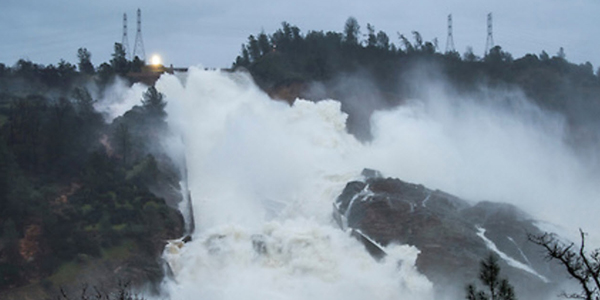By Jason Fordney
A “long-term systemic failure” of regulatory and industry practices caused the Oroville Dam crisis in February 2017, an independent forensics team said in a new report that recommends a reworking of broader dam safety practices across the country.
There was no single cause or chain of events that provoked the failure of the dam’s spillway, which was completed in 1968, the report says. The California Department of Water Resources (CDWR) was forced to use the dam’s emergency spillway on Feb. 12 after the dam’s main spillway failed, requiring the evacuation of 188,000 residents near Oroville in Butte County, about 75 miles north of Sacramento.
“The incident was caused by a complex interaction of relatively common physical, human, organizational and industry factors, starting with the design of the project and continuing until the incident,” the report said.
FERC required CDWR to engage with a forensic team to study the incident, with members recommended by the Association of State Dam Safety Officials and the United States Society on Dams. The team studied design and construction records, inspections, maintenance reports, investigations and other records.
Physical factors contributing to the failure included inherent vulnerabilities in spillway designs and construction of the dam, and the poor condition of the foundation rock underneath some spillway locations. There has also been inadequate attention paid to spillways, the report said, because spillway incidents don’t usually lead to loss of life and spillway incidents have been under-reported. CDWR might have also become complacent because of a lack of previous failures outside of the state, but the department should have been aware of accidents in other states and countries, the report said.
The main spillway had problems right after construction, according to the report, including a large crack in the concrete chute slab, and high underdrain flows were observed. The cracking and underdrain flows were considered normal, but repairs were “ineffective and perhaps detrimental.”
“The seriousness of the weak as-constructed conditions and lack of repair durability was not recognized during numerous inspections and review processes over the almost 50-year history of the project,” the report said.
It faulted the dam safety culture and program within CDWR, overconfidence and complacency regarding the dam’s condition, inadequate usage of industry knowledge, and bureaucratic constraints on staffing and expertise. The report suggested CDWR was also under pressure from the State Water Contractors, a group of 29 California public agencies, to control costs.
Environmental groups had warned CDWR and FERC about the facility, requesting during its 2005 relicensing that the hillside below the spillway be paved, but those pleas were rejected.
Water levels behind the FERC-regulated dam fell to nearly 50 feet below the height of a severely damaged emergency spillway at the time of the incident. (See Local Officials Appeal to FERC as Oroville Water Levels Recede.)
The report said CDWR has been too dependent on regulators and the regulatory process, and more broadly, the report recommends a strong “top down” safety culture at dams, with one executive charged with condition awareness and new expert staffing. More frequent physical inspections are not always sufficient, and CDWR has been a “somewhat insular” organization, inhibiting technical expertise, it said.
The report also recommended periodic reviews of original designs, construction and performance — more in-depth than the current reviews mandated by FERC every five years. It noted that in regular inspections by CDWR, FERC and others, the spillway was observed only from the headgate structure where only the upper, flat portion of the spillway could be seen. Repairs conducted in 2009 and 2013 were seen as routine and were not submitted for regulatory approval.
“The [independent forensics team] believes that both the California state and FERC dam safety regulations have been somewhat ambiguous regarding how comprehensive the five-year reviews were intended to be, which likely contributed to these reviews being overly relied upon but not sufficiently funded to serve as comprehensive reviews,” the report said.
It also said that prior to the incident, “the geology of the right abutment of the dam, including the hillside downstream of the emergency spillway crest structures, was fundamentally misunderstood by DWR, its consultants, [the California Division of Safety and Dams] and FERC.”
The 770-foot-high dam is part of the Oroville-Thermalito complex, which includes the Hyatt and Thermalito power plants totaling 933 MW, which had to be shut down during the incident, as well as power canals, afterbays and other facilities. The dam is part of the State Water Project, which provides water to 25 million people and 750,000 acres of irrigated farmland in California. It is the tallest in the U.S. and impounds one of California’s largest manmade lakes.
FERC has an open proceeding on the incident and in June ordered inspections of dam spillways to be completed by the end of 2017.





